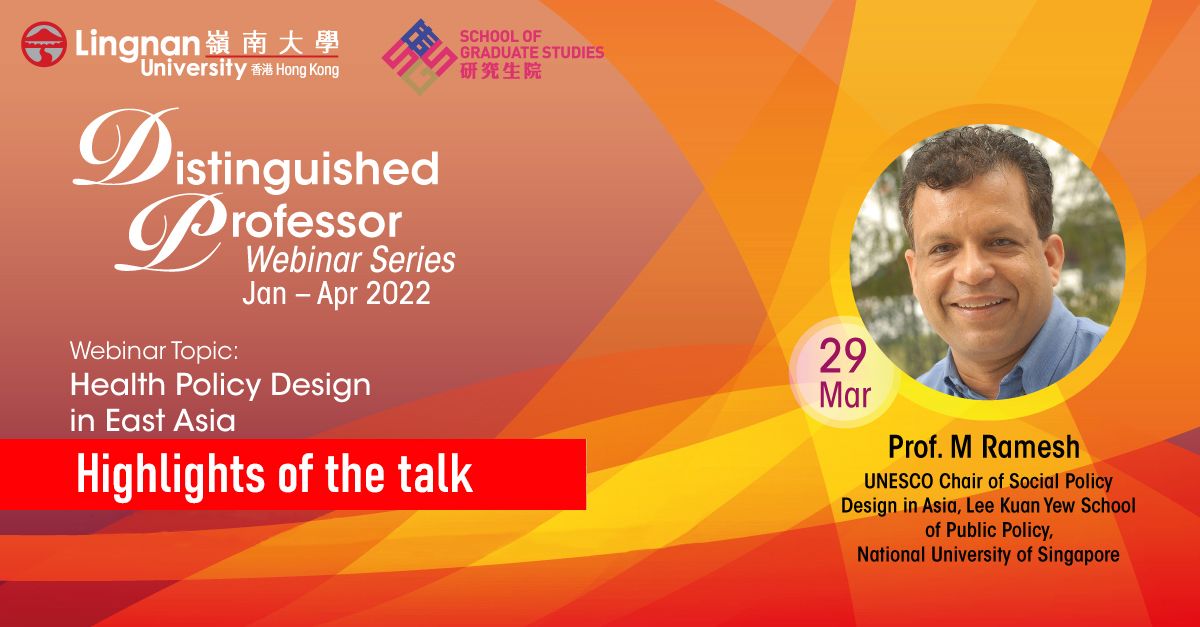Designing policies for better all-round health care

The Covid pandemic put specific issues of prevention and treatment very much in the spotlight over the past couple of years.
But for countries in East Asia, dealing with that is just one aspect of their longer-term challenge: how best to plan, administer and fund systems which make suitable health care accessible to all at a cost that is affordable for both households and governments.
Given the variables involved in terms of financing, policy options and expectations, there are no easy or definitive answers.
However, the fourth seminar in Lingnan University’s Distinguished Professor Webinar Series provided an insightful analysis of the different approaches adopted in China, Hong Kong, India, Singapore, Thailand and South Korea. And it considered each country’s relative success with reference to a comparison of key measures such as expenditure as a percentage of GDP, the population’s average life expectancy, and composite “health efficiency” scores.
Encouragingly, in that latter category, as calculated by Bloomberg in 2018, Hong Kong ranked first in the world with a score of 87.3 per cent.
In discussing these themes, Professsor M. Ramesh, UNESCO Chair of Social Policy Design in Asia at the National University of Singapore’s Lee Kuan Yew School of Public Policy, made use of research done for his recently published book Health Policy in Asia, which was co-written with Azad Bali.
This allowed him to assess distinct areas of policy design and what has influenced them, as well as the range of challenges related to governance, regulation, payment, and provision of services by the public and private sectors.
Noting first that one of the UN’s Sustainable Development Goals is to ensure by 2030 that “all people obtain the health services they need without suffering financial hardship when paying for them”, Ramesh saw this as a decidedly ambitious target.
Indeed, recent data has indicated that around half the world’s population still lacks access to reliable health care and roughly 200 million people a year are pushed into “extreme poverty” by having to meet the costs for essential or emergency care.
“Also, most government leaders don’t understand that health care policy really is complicated,” Ramesh said. “In no other sector are the problems so clear, but you also need a [public policy] perspective to solve the problems and make things work.”
The difficulties, he explained, arise for a number of reasons. Typically, these include pervasive asymmetry of information and moral hazards; contradictory interests of stakeholders, most notably the patients, providers and insurers; the legacy of past choices by governments and bureaucrats; and the innate characteristics of any health care system.
Therefore, when designing policy, it is vital to take full account of five critical functions and the tools that make each of them work.
In brief, the functions are governance, which is effected through stewardship and coordination; provision, usually involving both public and private ownership; and financing, which requires an element of “risk pooling”.
Besides that, there are the methods of payment, whether retrospective or prospective, and the regulatory regime needed to maintain overall probity and standards of care.
“These are distinct yet related functions which must be fit for purpose,” Ramesh said. “You need to get most of all five of them right to make a health care system work and achieve universal coverage at affordable cost.”
Elaborating on one of the tools – stewardship – he noted it involves envisioning a goal, setting the direction, mobilising resources, and specifying the responsibilities of various actors.
Coordination, in turn, has to be both vertical and horizontal in order to ensure different levels of government and all kinds of external agencies can have a say during the planning process and will know how things stand and what is expected of them once decisions are made.
“Broadly speaking, all Asian countries have improved governance,” Ramesh said. “They have increasingly clear goals and realise that you have to row and steer at the same time.”
He added that in such an asset-intensive sector, it is important to organise the service providers in ways that lead them to serve the public rather than only their own interests.
For private providers, that means curbing opportunities for profit maximisation at the expense of users. With publicly funded providers, it often involves motivating personnel to remain responsive to patients’ needs and paying sufficient attention to potentially harmful management issues.
To illustrate his main themes, Ramesh deftly drew on examples from around Asia and commended Hong Kong, Singapore and Thailand for their centralised, largely public systems with generally low costs and excellent outcomes.
“India and South Korea show the implications of health systems relying on private provision, but a lot can be learnt from their experience,” he said. “China is learning and improving rapidly. The government there accepts that it has the ultimate responsibility for providing universal health care and must do whatever it takes.”

